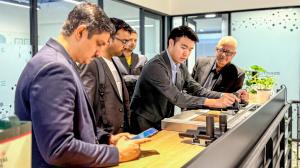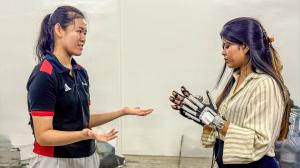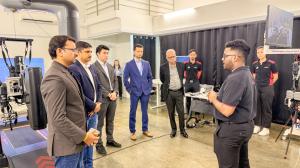Robotimize Hosts International Healthcare Delegates Exploring Comprehensive Rehabilitation Solutions

Even Koh, Group General Manager at Robotimize Group, discussing VivantePlexus™ integrated rehabilitation ecosystem and ACE™ partnerships to international healthcare delegates.

Jackson Lau, Product and Clinical Manager at Robotimize, demonstrates mirror therapy rehabilitation technology, showcasing specialized approaches addressing sensorimotor integration and neuroplastic recovery.

Even Koh engages in strategic dialogue during international delegation visit, discussing global rehabilitation markets, partnership models, and evidence-based technology deployment.
Robotimize Group hosts international healthcare delegations exploring comprehensive rehabilitation solutions and strategic partnership opportunities.
The delegations included healthcare professionals, technology evaluators, and business development representatives exploring rehabilitation robotics for various market contexts. Rather than one-time product presentations, the multi-day engagements enabled in-depth dialogue about clinical applications, implementation considerations, outcome measurement frameworks, and partnership models—reflecting Robotimize's commitment to ensuring that international adoption decisions rest on thorough understanding rather than superficial impressions.
Malaysia's position as one of the key regional hubs for Robotimize serves multiple strategic purposes: proximity to Southeast Asian healthcare markets experiencing rapid growth, established relationships with local clinical institutions providing implementation insights, multicultural environment reflecting the diversity of patient populations technologies must serve, and infrastructure supporting both product demonstrations and technical training programs.
"International delegations visiting our Malaysia hub recognize that rehabilitation technology adoption requires more than evaluating specifications—it demands understanding how systems integrate into clinical workflows, how data architecture supports personalized care, and how partnership models enable sustainable implementation," said Even Koh, Group General Manager, Robotimize Group.
VivantePlexus™ Core Concepts: Integrated Ecosystem for Comprehensive Care
Even Koh's presentations to visiting delegations emphasized VivantePlexus™ as more than product collection—it represents architectural philosophy where modular, interoperable technologies share unified data infrastructure enabling personalized therapy pathways and objective progress tracking across multiple therapeutic modalities.
This integration matters clinically because stroke survivors, neurological patients, and elderly individuals maintaining functional independence rarely benefit from isolated interventions. Comprehensive recovery requires coordinated approaches addressing motor function, cognitive abilities, sensory integration, balance, cardiovascular conditioning, and psychosocial wellbeing—precisely what VivantePlexus™ platform architecture enables.
The platform spans upper limb rehabilitation solutions for hand and arm function, lower limb systems supporting gait training and functional electrical stimulation, cycling-based rehabilitation platforms, and complementary technologies for cognitive stimulation, balance training, and telerehabilitation extending clinical support into home and community settings.
Even Koh's explanations also covered ACE™ (Alliance for Collaborative Excellence)—Robotimize's strategic partnerships portfolio bringing specialized technologies from global developers into the comprehensive care ecosystem. Rather than developing every therapeutic technology internally, ACE™ enables curated collaborations bringing specialized expertise in mobility training, sensory feedback systems, virtual rehabilitation environments, recovery technologies, and advanced therapeutic modalities.
"VivantePlexus™ and ACE™ represent two sides of comprehensive care—integrated platform technologies we develop internally, and specialized partnerships bringing best-in-class innovations into the ecosystem. Both serve the same goal: ensuring clinicians access diverse, evidence-based tools addressing patients' complete recovery needs," explained Even Koh.
Mirror Therapy and Specialized Rehabilitation Technologies
Mirror therapy represents a well-established neurological rehabilitation technique where patients observe mirrored reflections of unaffected limbs while attempting movements with affected limbs—visual feedback that can enhance motor recovery by engaging neuroplastic mechanisms. This approach demonstrates how specialized rehabilitation modalities address specific therapeutic needs within comprehensive care frameworks.
The Robotimize team’s demonstrations illustrated the importance of diverse therapeutic approaches in modern rehabilitation. Neurological recovery often requires multiple intervention strategies—combining robotic assistance with sensory feedback techniques, motor training with cognitive engagement, and technology-enabled precision with evidence-based clinical protocols. Not every patient requires every modality, but comprehensive rehabilitation centers benefit from accessing specialized approaches that can be tailored to individual clinical presentations, recovery stages, and therapeutic goals.
The demonstrations also exemplified how rehabilitation technology continues evolving beyond traditional exercise-based approaches. Contemporary practice increasingly incorporates sensorimotor integration techniques, neuroplasticity principles, objective measurement capabilities, and multimodal interventions that address the complex interactions between motor control, sensory processing, and cognitive function.
International delegates particularly appreciated hands-on demonstrations that revealed practical considerations beyond technical specifications. Experiencing how technologies function in clinical contexts, observing setup procedures and workflow integration, understanding patient interaction requirements, and discussing real-world implementation challenges provide insights essential for informed adoption decisions.
Leadership Dialogue: Strategic Vision and Market Understanding
Beyond technology demonstrations, delegation visits included strategic dialogues addressing market dynamics, healthcare system variations, regulatory pathways, reimbursement frameworks, and partnership models enabling successful international deployment.
These leadership-level conversations recognize that rehabilitation technology adoption involves more than clinical effectiveness—it requires understanding local healthcare financing mechanisms, navigating regulatory approval processes, adapting to cultural preferences around technology and care delivery, building relationships with key opinion leaders, and establishing service infrastructure supporting long-term technology utilization.
Even Koh's extensive experience managing Robotimize's regional operations provides valuable insights for international partners exploring market entry or expansion. Malaysia's healthcare system combines public and private sectors, treats diverse patient populations, balances cost constraints with quality aspirations, and navigates regulatory frameworks influenced by multiple international standards—complexity that mirrors challenges many healthcare markets face.
Discussion topics included how to structure pilot programmes de-risking technology adoption, what outcome metrics resonate with different stakeholder groups, how to sequence market entry across countries with varying readiness levels, what training infrastructure ensures clinical teams use technologies effectively, and how partnership models balance technology access, local capability building, and sustainable business relationships.
"International healthcare markets differ significantly in regulatory requirements, reimbursement structures, clinical practices, and technology readiness. Successful deployment requires understanding these nuances rather than assuming one-size-fits-all approaches. We encourage these conversations where we learn from partners' market knowledge while sharing implementation insights," said Even Koh.
The dialogues also addressed Robotimize's growth trajectory—global regional hubs, expanding partner networks across Asia-Pacific, North America, and Europe, and ongoing technology development advancing VivantePlexus™ capabilities. International partners evaluating collaboration want confidence that technology companies can support long-term relationships, not just initial sales transactions.
Patient-Centered Design in Rehabilitation Technology
Throughout the product demonstrations, conversations explored how effective rehabilitation technology navigates the tension between standardization and customization. Engineering efficiency favors standardized designs serving broad populations, but clinical reality demands accommodation of enormous human variability—anatomical differences, functional impairments, cognitive abilities, and individual therapeutic goals.
Successful devices emerge from iterative collaboration between engineers, clinicians, and patients. Engineers contribute technical knowledge about materials, sensors, actuators, and control systems. Clinicians provide insights about patient needs, workflow constraints, and outcome priorities. Patients offer perspectives on comfort, usability, motivation, and real-world functionality. This participatory design process produces technologies more likely to achieve sustained clinical adoption.
International delegates engaged with practical questions: How do systems accommodate diverse patient anatomies? What training infrastructure supports clinical teams? How does maintenance impact long-term sustainability? What evidence demonstrates clinical effectiveness and cost-effectiveness? These conversations reflect understanding that technology adoption involves comprehensive assessment beyond initial impressions.
The demonstrations reinforced that rehabilitation success depends on integrated approaches where multiple therapeutic modalities work together, objective data informs clinical decisions, and technologies enhance rather than replace the therapeutic relationship between patients and clinicians.
Comprehensive Rehabilitation Solutions and Implementation Strategy
The comprehensive showroom experience provided international delegates with holistic understanding of modern rehabilitation delivery—not isolated technologies but integrated ecosystems where diverse modalities work together addressing patients' complete recovery needs across hospital, home, and community settings.
Effective rehabilitation centers increasingly recognize that patient outcomes improve when facilities offer coordinated therapeutic options spanning motor rehabilitation, cognitive training, sensory integration, balance and coordination, cardiovascular conditioning, and functional task practice. This comprehensive approach enables personalized treatment plans matching interventions to individual clinical presentations, recovery stages, and therapeutic goals rather than forcing patients into limited available modalities.
The systematic walkthrough progressed through rehabilitation domains illustrating how different therapeutic approaches complement each other: upper limb technologies addressing hand and arm function that enable daily living activities; lower limb systems supporting gait and mobility essential for community participation; cycling-based platforms combining motor exercise with neuromuscular stimulation; cognitive tools maintaining mental acuity; balance systems preventing falls; recovery modalities supporting tissue healing; and telerehabilitation extending clinical support beyond facility walls into patients' homes.
This integrated presentation format helps healthcare leaders envision transformation from equipment purchases to comprehensive care delivery models. Modern rehabilitation succeeds not through acquiring the most advanced individual devices but through building coordinated capabilities where clinical teams can personalize therapy, track objective progress across multiple domains, and adapt interventions based on measurable outcomes.
Beyond technology capabilities, the discussions addressed practical implementation realities that determine adoption success: facility infrastructure requirements and spatial planning, clinical workflow integration minimizing disruption to existing operations, staff training approaches building competency and confidence, maintenance and technical support ensuring sustained functionality, data governance protecting patient privacy while enabling outcome measurement, and partnership models supporting long-term relationships rather than transactional equipment sales.
Discussions reflected rehabilitation technology market maturation—moving from experimental early adoption toward evidence-based mainstream integration. International healthcare professionals now approach technology evaluation with sophisticated frameworks examining not just clinical efficacy but implementation feasibility, long-term sustainability, interoperability with existing systems, vendor stability and support capabilities, and alignment with institutional strategic priorities. This analytical rigor benefits patients by ensuring that adopted technologies deliver sustained value rather than becoming expensive equipment gathering dust.
Malaysia as Strategic Regional Hub: Gateway for Asia-Pacific Markets
The Malaysia hub for Robotimize serves as strategic gateway for Asia-Pacific market engagement, offering several advantages for international partners:
• Geographic Accessibility: Central location enabling convenient access from South Asia, Southeast Asia, East Asia, and Oceania—reducing travel barriers for delegation visits and regional training programs.
• Multicultural Environment: Malaysia's diverse population and healthcare system provide insights applicable across varied cultural contexts—language considerations, family involvement in care decisions, technology acceptance patterns, and aesthetic preferences.
• Regulatory Familiarity: Experience navigating medical device regulations influenced by multiple international frameworks provides valuable guidance for partners pursuing approvals in their own markets.
• Clinical Partnerships: Established relationships with Malaysian healthcare institutions enable visiting delegates to observe technologies in actual clinical use—understanding real-world implementation beyond controlled demonstrations.
• Technical Infrastructure: Comprehensive demonstration facilities, training environments, and service capabilities support not just initial technology evaluation but ongoing partnership development and capability building.
The recent delegation visits demonstrates the effectiveness of the Malaysia hub—enabling Robotimize to host multiple international groups efficiently, provide comprehensive technology experiences, engage in strategic dialogue about market dynamics, and build relationships supporting long-term collaboration.
Evidence-Based Deployment: Supporting Informed Decisions
Throughout delegation visits, Robotimize emphasized evidence-based technology adoption—ensuring that international partners' decisions rest on clinical validation, outcome data, implementation experiences, and realistic understanding of both capabilities and limitations.
This commitment manifests through transparent performance disclosure, published research and case studies, candid discussion of appropriate applications and contraindications, honest assessment of implementation challenges and solutions, and connections to clinical partners sharing real-world experiences.
Healthcare providers considering substantial technology investments deserve complete information—not just marketing claims but validated evidence, implementation insights, and honest dialogue about what works, for whom, under what conditions.
"Our responsibility extends beyond selling equipment to ensuring that international partners succeed in implementing technologies effectively. That requires honest dialogue about clinical evidence, realistic expectations about outcomes, thorough training, and ongoing support. We succeed when our partners succeed in improving patient outcomes," emphasized Even Koh.
Looking Forward: Building Global Rehabilitation Ecosystem
The recent international delegation visits to the Malaysia showroom represent ongoing efforts to build global rehabilitation ecosystem—connecting healthcare providers, technology developers, researchers, and policymakers around shared commitment to evidence-based innovation improving patient outcomes across diverse populations and healthcare contexts.
As rehabilitation technology continues advancing—through AI-enabled personalization, telerehabilitation extending care access, sensor technologies enabling objective measurement, and integrated platforms coordinating comprehensive treatment—international collaboration becomes increasingly important. Progress emerges through shared learning, transparent evidence, and partnerships built on mutual respect and commitment to patient wellbeing.
Robotimize will continue welcoming international healthcare professionals exploring rehabilitation solutions—providing comprehensive technology demonstrations, engaging in strategic dialogue, sharing implementation insights, and building relationships supporting effective technology adoption that ultimately serves patients seeking to overcome functional limitations and achieve independent, meaningful lives.
About Robotimize Group
Robotimize Group is a next-generation health technology company headquartered in Singapore, specialising in intelligent rehabilitation robotics and digital neurotechnologies. Through VivantePlexus™, its integrated rehabilitation ecosystem, and ACE™, its strategic partnerships portfolio, Robotimize delivers comprehensive solutions that support motor, cognitive, and neurological recovery across hospital, home, and community settings. With regional hubs in Malaysia and Singapore, and a growing international partner network, Robotimize is redefining rehabilitation delivery—making it more personal, adaptive, and accessible. For more information, visit: www.robotimize.tech
Jerry HONG
Robotimize Group
+60 11-1224 1674
email us here
Visit us on social media:
LinkedIn
Instagram
YouTube
Legal Disclaimer:
EIN Presswire provides this news content "as is" without warranty of any kind. We do not accept any responsibility or liability for the accuracy, content, images, videos, licenses, completeness, legality, or reliability of the information contained in this article. If you have any complaints or copyright issues related to this article, kindly contact the author above.


